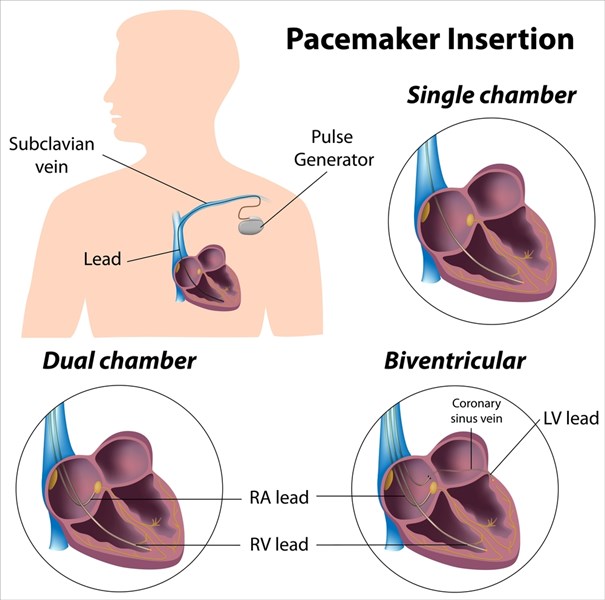Psychological adjustment
Ensure that patients are receiving adequate education and support before and after implantation. Living with an implantable device can be emotionally challenging and may provoke ongoing anxiety or depression. Patients may be concerned about receiving a shock, changes in body image, losing control, relationships, and uncertainty about the future.
Information the patient needs to carry with them
Ensure that patients have information from the device company including a card outlining device details and settings as well as what to do in the event of symptoms or shock. Encourage patients to carry this card at all times and check that they should know who to contact in the event of concerns.
Driving
Driving regulations associated with ICDs vary in different states in Australia as well as in other countries and clinicians should access local resources for more detailed information.
General guidelines are as follows:
- Following a cardiac arrest, driving is not normally allowed after the insertion of a device until the patient has experienced an event free period of six months
- Devices implanted for primary prevention or CRT may be eligible to drive after one month
- Patients with ICDs cannot usually hold a commercial driving licence
Exercise
Patients with a device are safe to exercise. The exercise specialist should be aware of the reason for the device (i.e., atrial versus ventricular arrhythmias, primary prevention, CRT) and device settings should be recorded. Exercise programmes should be modified to ensure upper limb activity is restricted on the side of implantation in the initial post implantation period. The number of weeks for this will be guided by the treating cardiologist. For ICDs, exercise should be prescribed at an intensity to keep the heart rate at least 10-15 beats/min below the threshold for the delivery of therapies. Contact sports should be avoided to prevent blunt trauma injury and damage to the device.
Sexual intimacy
Heart rate increases during sex may equate to that achieved during other forms of exercise. Devices should be programmed to prevent shock during sex. However, if the patient receives a shock, his or her partner may also feel a tingling sensation. Medical advice should be sought to enable the device to be reprogrammed.
Electromagnetic interference (EMI)
Most devices used on a daily basis will not affect modern implantable devices. As a general rule, appliances or machinery that emits strong EMI should be kept 30-60 cm away from the implantable device.
Recommendations relating to the use of common appliances and situations are summarised below:
- Mobile phone should be held to the ear on the opposite side to the device and should not be carried in a pocket within 15cm of the device.
- Antitheft devices: Individuals with an implantable device can pass through doorways with antitheft devices (e.g., in libraries and department stores) at a normal pace but should not linger in the area.
- Airport security archways will not harm devices but the metal in the device will set off the security alarms. Individuals with a device should notify airport staff and show their Medical Device ID card. The wand used by the security staff may temporarily affect the device if held over it for a period over 30 seconds. Individuals should ask security staff to perform the search quickly or conduct a hand search.
- Medical and dental procedures require cardiologist approval for example:
- Magnetic resonance imaging (MRI) is not usually performed in patients with implantable devices except when the device is MRI conditional, meaning that patients can safely undergo an unmonitored scan following a programming change to the device.
- Diathermy, electrocautery and radiation treatment require consultation with the treating cardiologist as devices may be required to be turned off or may require protection during the procedure.
- Transcutaneous electrical nerve stimulation (TENS) may affect the device and so should be used only in consultation with the treating cardiologist.
Appliances considered safe to use or be near with an implantable device, under normal circumstances:
- Electric blankets
- Electric razors
- Electric can openers
- CD/DVD players
- Blenders
- Hair dryers
- Heating pads
- Microwave ovens
- Stoves
- Pagers
- Personal computers
- Fax machines
- Remote controls
- TV or radio towers
Appliances to be kept 30-60cm from the implantable device
- Arc welders
- Magnetic wands
- Chain saws
- Lawn mowers
- Leaf blowers
- Stereo speakers
- CB radio antennas
- Slot/poker machines
- Drills (corded or cordless)
Appliances/ actions to avoid
- Bathroom scales that record body fat
- Operating a jack hammer
- Leaning over running motors and alternators such as the engine of a running car
- Using stun/laser guns
 Pathophysiology
Pathophysiology
 Treatment & Management
Treatment & Management
 Exercise
Exercise
 Medications
Medications
 Psychosocial Issues
Psychosocial Issues
 Patient Education
Patient Education
 Behaviour Change
Behaviour Change
 Clinical Indicators
Clinical Indicators
 Pathophysiology
Pathophysiology
 Treatment & Management
Treatment & Management
 Exercise
Exercise
 Medications
Medications
 Psychosocial Issues
Psychosocial Issues
 Patient Education
Patient Education
 Behaviour Change
Behaviour Change
 Clinical Indicators
Clinical Indicators
 Pathophysiology
Pathophysiology
 Treatment & Management
Treatment & Management
 Exercise
Exercise
 Medications
Medications
 Psychosocial Issues
Psychosocial Issues
 Patient Education
Patient Education
 Behaviour Change
Behaviour Change
 Clinical Indicators
Clinical Indicators


